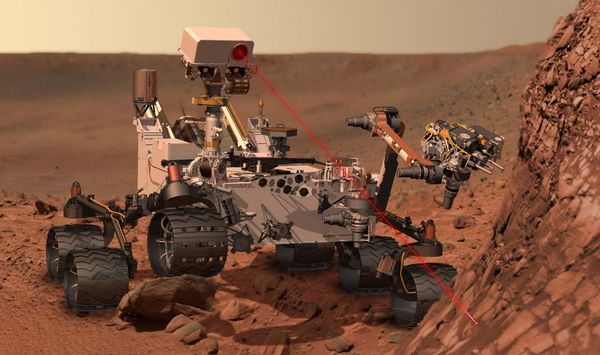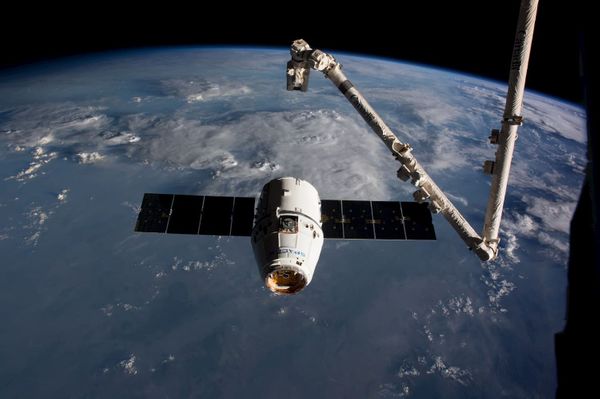14 stories of metal and rocket fuel plummets towards the Atlantic Ocean. Via Elon Musk/SpaceX
CRS-16 was supposed to be a 'boring' cargo launch after SpaceX nailed its 3rd reflight of a Block 5 Falcon 9 booster on Monday. After a flawless boost of a second stage and capsule into space, the Falcon 9 began its signature maneuver back to Earth for landing. However, the booster entered an unplanned spin shortly before landing. Following a cut livestream feed and audible cheers and gasps from SpaceX viewers, the booster came to rest just off the Florida shore. What the hell happened on a routine NASA cargo launch?
What went wrong?
Grid fin hydraulic pump stalled, so Falcon landed just out to sea. Appears to be undamaged & is transmitting data. Recovery ship dispatched.
— Elon Musk (@elonmusk) December 5, 2018
A failure in the aerodynamic control surfaces led to an unrecoverable series of events.
Return to Launch Site (RTLS) landings like the one attempted by CRS-16/B1050 take place over 3 main stages. First, after separating from the second stage, the first stage booster flips around and conducts the boostback burn. This burn lifts the stage's apogee (highest point of travel) and reverses its velocity back towards land. While the second stage accelerates faster and faster towards orbit, Stage 1 coasts to apogee and begins to accelerate towards the launch site. At high altitudes, aerodynamic forces are minimal in the thin atmosphere and cold gas thrusters make minor changes in attitude in near-vacuum.. As the stage accelerates and descends, these forces increase rapidly. Stage 1 conducts the entry burn to reduce its downward velocity.
In the thicker air, grid fins begin to contribute meaningful control input. The rocket is actually angled as it descends to increase the lift of the cylindrical body, decelerating and saving fuel. These large fins are rotated by hydraulic actuators, pressurized fluid systems, which can impart enough force to keep the stage under control. According to Elon Musk, a failure in the hydraulic system locked up these fins. Not only was the stage unable to make fine corrections in its trajectory, the angled fins imparted a roll to the stage.
Engines stabilized rocket spin just in time, enabling an intact landing in water! Ships en route to rescue Falcon. pic.twitter.com/O3h8eCgGJ7
— Elon Musk (@elonmusk) December 5, 2018
Full video of the perilous descent was released by SpaceX shortly after launch
At this point the video feed from the stage was cut by ground controllers. Multiple video feeds from spectators revealed the fate of the out of control stage.
Wait, it landed anyways?
Tracking shot of Falcon water landing pic.twitter.com/6Hv2aZhLjM
— Elon Musk (@elonmusk) December 5, 2018
Falcon 9 B1050 makes a soft landing in the Atlantic ocean intact.
Despite the failed hydraulic control system, the stage was able to land in one piece in the waters off the coast of Cape Canaveral. This is not the first time a Falcon 9 booster has landed in the ocean. Earlier this year, an experimental high thrust landing attempt on GovSat-1 resulted in a Falcon 9 first stage floating in the Atlantic, hundreds of miles off-shore.
This rocket was meant to test very high retrothrust landing in water so it didn’t hurt the droneship, but amazingly it has survived. We will try to tow it back to shore. pic.twitter.com/hipmgdnq16
— Elon Musk (@elonmusk) January 31, 2018
B1032 floating in the Atlantic. It was later destroyed by demolition experts.
Even further back, SpaceX conducted soft water landing tests in the early days of their reusability testing program. The first water landing test was in July 2014 and resulted in barely usable, corrupted video. Five boosters have successfully landed in the water prior to this mission and twenty boosters landed on Autonomous Spaceport Drone Ships.
How will SpaceX fix it?
Pump is single string. Some landing systems are not redundant, as landing is considered ground safety critical, but not mission critical. Given this event, we will likely add a backup pump & lines.
— Elon Musk (@elonmusk) December 5, 2018
Redundant systems are expensive and impact payload, but Block 5 boosters are expected to land and refly up to 100 times.
Elon Musk was quick to throw out a potential solution for future Falcon 9 flights. Safety margins and redundant systems are valuable and rare commodities in spaceflight applications. Doubling the mass of systems "just in case" usually isn't feasible when safety margins can be as low as 1.25x the expected load. To save weight, the hydraulic system is already an open-loop, dumping fluid after a single use. A prior issue with the hydraulic grid fins in 2015 was resolved by adding more fluid to this system.
How will this impact future SpaceX missions?
NASA’s Joel Montalbano: all indications Dragon spacecraft is performing normally. Berthing at approx. 6 am EST Saturday.
— Jeff Foust (@jeff_foust) December 5, 2018
CRS-16 continues with Dragon headed towards the ISS, where it will remain for one month before returning.
Despite the intense landing, the primary objective of the mission was 100% successful. As SpaceX tries to tow the booster back to shore, many eyes point towards SpaceX's next mission. GPS-III-2 is an expensive Department of Defense (DoD) payload scheduled for NET December 18th. However, no landing was planned for that mission anyways.
Another concern is the risk to life and property when a rocket booster loses control while headed back to land. Hans Koenigsmann, VP of Mission Assurance, noted that the "first stage targets a point in the water" by default and that the rocket's "safety functions worked perfectly" during the wild descent. Range safety is a persistent concern for all rocket launch companies. Tracking radars and GPS sensors monitor the trajectory of the vehicle at all times and use onboard explosives to destroy the vehicle if it could begin to fly off-course.
What about the payload?
Cargo Dragon (C112 Flight 2) is currently headed to the ISS with over 5,600lbs (2,40kg) of cargo including supplies and experiments for the astronauts onboard. Experiments include student and government built CubeSats, plant growth studies, a Marvel Guardians of the Galaxy tie-in, and more "Mousetronauts".
- TechEdSat-6 - a CubeSat scale Entry, Descent, and Landing experiment.
- Aeroponic Farming in Microgravity - Part of a Marvel Tie-in with Guardians of the Galaxy, this experiment will test nozzle atomization for aeroponic plant growth.
- UNITE – The Undergraduate Nano Ionospheric Temperature Explorer CubeSat - "a CubeSat that measures plasma properties in the lower ionosphere"
Also SpaceX confirmed this launch was the second launch of improved Composite Overwrapped Pressure Vessels (COPV) in the second stage of the rocket. A failure in a COPV caused the Rapid Unscheduled Disassembly (RUD) of AMOS-6 during a routine static fire test in 2016. NASA required SpaceX to redesign these COPVs and to demonstrate their reliability on seven flights before astronauts could fly on Falcon 9. Crew Dragon's first unmanned flight is currently scheduled for NET January 17th 2019, with a crewed flight NET April 2019.







